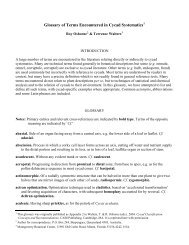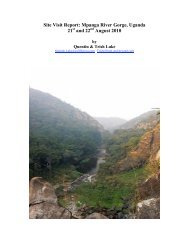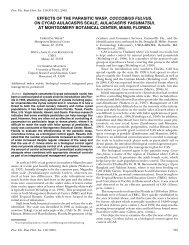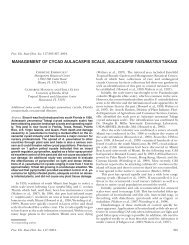Cycas-circinalis-cas.. - Cycad Specialist Group
Cycas-circinalis-cas.. - Cycad Specialist Group
Cycas-circinalis-cas.. - Cycad Specialist Group
You also want an ePaper? Increase the reach of your titles
YUMPU automatically turns print PDFs into web optimized ePapers that Google loves.
harvest , ratio of female: male individuals in each population, leaf size, number of leaves<br />
produced and number of fruits produced in harvested and non-harvested populations, and<br />
resprouting rates of harvested stems.<br />
4.0 Results<br />
4.1 Patterns of use and harvest of C. <strong>circinalis</strong> in NBR<br />
Patterns of use and harvest of C. <strong>circinalis</strong> in the NBR varied across communities<br />
and between Tamil Nadu and Kerala states (Table 3).<br />
4.1.1 Leaf and fruit harvest<br />
The focus groups discussions and informal interviews revealed that in Kerala and<br />
Tamil Nadu the indigenous communities harvest mainly the fruit and the young leaves of<br />
C. <strong>circinalis</strong> (Table 3). These are considered delicacies and are highly valued. In Tamil<br />
Nadu, the villagers of Velleri Combei and Semenarai relish the young leaves and steamed<br />
fruit. However, the people of Dhalamukh and Gandavayal do not. These preferences<br />
seem related to the distance of the village from the resource (Table 2). In Kerala, the<br />
Kattu naickans of the villages of Appankaapu and Thandankallu in Nilambur are keen<br />
harvesters of C. <strong>circinalis</strong> fruit and the young leaf, but the Cholanaikans of Alakal and<br />
Maancheery showed less interest in these. The focus group discussion also revealed<br />
reports harvest by non-indigenous people (see below).<br />
The young leaves are collected around October to November and in mid April,<br />
when flushing occurs and all new leaves from an individual are harvested. These are<br />
brought only for home use. Except for one harvester from Semenarai, most of the<br />
harvesters talked about making only one trip to the forests for the leaves. The harvesters<br />
also mentioned that as soon as they pinch out the young leaves, within a month a new set<br />
of flush is observed. All of them mentioned this as being the most delicious part of the<br />
plant. The outer skin of the leaf is removed and the cut leaf is then boiled and the water<br />
drained off before the leaf is cooked. The leaves are also cooked with lentils.<br />
The harvesters reported that the fruits are not available for harvest every year.<br />
The fruit is collected during the months of July and August in the Nilambur area and<br />
between February and March in the Nilgiris area. While speaking to the women of the<br />
lower elevation in Nilgiris (Gandavayal), they repeatedly emphasized how actually it was<br />
the women in the hills who were experts at cleaning and processing the fruit of C.<br />
<strong>circinalis</strong>.<br />
Although in Tamil Nadu C. <strong>circinalis</strong> fruit is harvested for home consumption, in<br />
Kerala there is also local demand for the dried fruit for medicine. The harvest is heavy<br />
here as the harvesters harvest the fruit and sell it after some processing and drying to the<br />
market. The ripe fruit is picked (about 25 kg per day) and smoked on a bamboo mat and<br />
then dehusked and dried. Harvesters reports that 25 kgs of fruit would yield only up to<br />
two kg of dried fruit. Some of the harvesters talked about washing the fruit in running<br />
water before drying it. In Thandankallu, the people reported leaving the outer shell of the<br />
fruit to rot in a dark corner of the house, then dehusking. Apparently the fungus on the<br />
9






